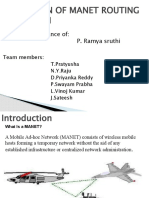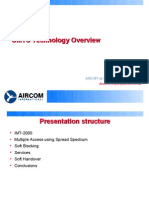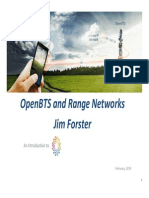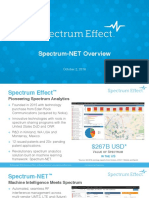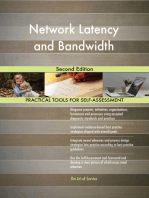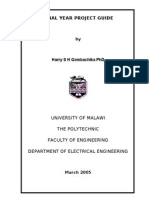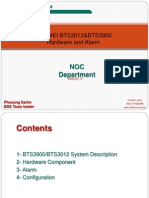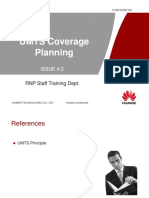WCDMA Basic 18 Spectrum Test and Instructions For YBT250
WCDMA Basic 18 Spectrum Test and Instructions For YBT250
Uploaded by
Sangwani NyirendaCopyright:
Available Formats
WCDMA Basic 18 Spectrum Test and Instructions For YBT250
WCDMA Basic 18 Spectrum Test and Instructions For YBT250
Uploaded by
Sangwani NyirendaOriginal Title
Copyright
Available Formats
Share this document
Did you find this document useful?
Is this content inappropriate?
Copyright:
Available Formats
WCDMA Basic 18 Spectrum Test and Instructions For YBT250
WCDMA Basic 18 Spectrum Test and Instructions For YBT250
Uploaded by
Sangwani NyirendaCopyright:
Available Formats
Internal
Spectrum Test and
Instructions for YBT250
ISSUE1.0 www.huawei.com
HUAWEI TECHNOLOGIES CO., LTD. Huawei Confidential
Page 2 Security Level:
The WCDMA system is a restricted
communication system by the
interference. The network quality,
capacity and coverage are all
related to the background noise.
www.huawei.com
When design the radio network, we
must obtain the strength of the
background noise in the coverage
area.
HUAWEI TECHNOLOGIES CO., LTD.
If strong interference exists within
Page 3 Security Level:
After studying this course, you
should be able to:
› Know the sources of electromagnetic
background interference.
› Master the methods for electromagnetic
background test.
www.huawei.com
› Know how to use YBT250 for spectrum test.
HUAWEI TECHNOLOGIES CO., LTD.
Page 4 Security Level:
Chapter 1 Impact of Electromagnetic
Interference on the System
Chapter 2 Sources of Electromagnetic
Background Interference
Chapter 3 Introduction to Interference
Test Tools www.huawei.com
Chapter 4 Methods for Electromagnetic
Background Test
Chapter 5 Instructions for YBT250
HUAWEI TECHNOLOGIES CO., LTD.
Page 5 Security Level:
Chapter 1 Impact of Electromagnetic Interference
on the System
1.1 Bands Used in the WCDMA System
1.2 Interference Requirements for UE
Reception
www.huawei.com
1.3 Interference Requirements for NodeB
Reception
HUAWEI TECHNOLOGIES CO., LTD.
Page 6 Security Level:
Bands used in the WCDMA system
UpLink Band DownLink Band
Operating
UE transmit, Node B UE receive, Node B
Band
receive transmit
I 1920 - 1980 MHz 2110 -2170 MHz
II 1850 -1910 MHz 1930 -1990 MHz
III 1710-1785 MHz 1805-1880 MHz
IV 1710-1755 MHz 2110-2155 MHz
V 824 - 849MHz 869-894MHz
VI 830-840 MHz 875-885 MHz
VII 2500 - 2570 MHz 2620 - 2690 MHz
www.huawei.com
VIII 880 - 915 MHz 925 - 960 MHz
IX 1749.9 - 1784.9 MHz 1844.9 - 1879.9 MHz
Band I, II, V and VII are most popular used in the world.
Band I is used in China.
HUAWEI TECHNOLOGIES CO., LTD.
Impact of Electromagnetic Interference on the System
Page 7 Security Level:
Determine the impact of interference on the system according
to experience, as shown in the following table (for UE). Interference That Seriously
Interference Level
Acceptable Acceptable Effects Equipment Indexes
Not Affecting
Interference Level Interference Level Instead of Equipment Running, Protocol
Interference Band Receiver Sensitivity
(With the Sensitivity (With the Sensitivity Lower Than the Maximum Signal Requirement
(With the Sensitivity
Worsened by 3 dB) Worsened by 6 dB) Strength (-25 dBm) the UE Can
Worsened by 0.1 dB)
Receive by 10 dB
The required
2110-2170 MHz (co- -101 dBm/ 3.84
-117 dBm/ 3.84 MHz -96 dBm/ 3.84 MHz -35 dBm/ 3.84 MHz sensitivity is -107
frequency interference) MHz
dBm/ 3.84 MHz.
2095-2185 MHz (adjacent -66 dBm/ 3.84
channel interference, MHz (with the
-82 dBm/ 3.84 MHz -66 dBm/ 3.84 MHz -61 dBm/ 3.84 MHz -16 dBm/ 3.84 MHz
deviated from the carrier sensitivity
by 5 MHz) worsened by 3 dB)
-56 dBm/ 3.84
2095-2185 MHz (in-band
MHz (with the
blocking, deviated from -72 dBm/ 3.84 MHz -56 dBm/ 3.84 MHz -51 dBm/ 3.84 MHz -6 dBm/ 3.84 MHz
sensitivity
the carrier by 10 MHz)
worsened by 3 dB)
www.huawei.com
-44 dBm/ 3.84
2095-2185 MHz (in-band
MHz (with the
blocking, deviated from -60 dBm/ 3.84 MHz -44 dBm/ 3.84 MHz -39 dBm/ 3.84 MHz 6 dBm/ 3.84 MHz
sensitivity
the carrier by 15 MHz)
worsened by 3 dB)
-44 dBm/ 3.84
Other bands (out-of-band
MHz (with the
blocking and spurious -60 dBm/ 3.84 MHz -44 dBm/ 3.84 MHz -39 dBm/ 3.84 MHz 6 dBm/ 3.84 MHz
sensitivity
response)
worsened by 3 dB)
Note:
dBm/Hz refers to the level unit of single-tone signals.
The reference port for measurement is the reception port of the UE antenna.
The reference requirements are based on the protocol TSG25.101.
HUAWEI TECHNOLOGIES CO., LTD.
Impact of Electromagnetic Interference on the System
Page 8 Security Level:
Determine the impact of interference on the system
according to experience, as shown in the following table
(for NodeB). Interference Level
Not Affecting
Acceptable
Interference Level
Acceptable
Interference Level
Interference That Seriously
Effects Equipment Indexes
Instead of Equipment Running, Specification for NodeB
Interference Band Receiver Sensitivity (With the (With the
Lower Than the Maximum Indexes
(With the Sensitivity Sensitivity Sensitivity
Signal Strength (-70 dBm) the
Worsened by 0.1 dB) Worsened by 3 dB) Worsened by 6 dB)
UE Can Receive by 10 dB
1920-1980 MHz (co- The sensitivity specification
-121 dBm/ 3.84 MHz -105 dBm/ 3.84 MHz -100 dBm/ 3.84 MHz -80 dBm/ 3.8 4MHz
frequency interference) is -123 dBm/3.84MHz.
1900-2000 MHz
(adjacent channel
-42 dBm/ 3.84 MHz (with the
interference, deviated -63 dBm/ 3.84 MHz -47 dBm/ 3.84 MHz -42 dBm/ 3.84 MHz -22 dBm/ 3.84 MHz
sensitivity worsened by 6 dB)
from the carrier by 5
MHz)
1900-2000 MHz (in-band -30 dBm/ 3.84 MHz (with the
-51 dBm/ 3.84 MHz -35 dBm/ 3.84 MHz -30 dBm/ 3.84 MHz -10 dBm/ 3.84 MHz
blocking) sensitivity worsened by 6 dB)
1900-2000 MHz (out-of- -25 dBm/ 3.84 MHz (with the
-46 dBm/ 3.84 MHz -30 dBm/ 3.84 MHz -25 dBm/ 3.84 MHz -5 dBm/ 3.84 MHz
band blocking) sensitivity worsened by 6 dB)
935-960 MHz www.huawei.com
16 dBm/Hz (with the
1805-1880 MHz (out-of- -5 dBm/Hz 11 dBm/Hz 16 dBm/Hz 36 dBm/Hz
sensitivity worsened by 6 dB)
band blocking)
Other bands (out-of- -5 dBm/Hz (with the
-26 dBm/Hz -10 dBm/Hz -5 dBm/Hz 15 dBm/Hz
band blocking) sensitivity worsened by 6 dB)
Note:
dBm/Hz refers to the level unit of single-tone signals.
The reference port for measurement is the reception port of the NodeB antenna.
The reference requirements are based on the protocol TSG25.101.
During analysis, the index for adjacent channel interference and in-band blocking is 10 dB better than that specified in the protocol. This is the RF index the NodeB
can ensure.
HUAWEI TECHNOLOGIES CO., LTD.
Impact of Electromagnetic Interference on the System
Page 9 Security Level:
Interference requirements for UE reception (taking the
band 2110 - 2170 MHz as an example)
› Interference band: 2110 - 2170 MHz
› Interference level not affecting receiver sensitivity: -117 dBm/3.84 MHz, with
the sensitivity worsened by 0.1 dB
› Acceptable interference: -101 dBm/3.84 MHz, with the sensitivity worsened
by 3 dB
› Acceptable interference: -96 dBm/3.84 MHz, with the sensitivity worsened by
6 dB
› Interference that seriously effects equipment indexes instead of equipment
www.huawei.com
running:
-35dBm/3.84MHz, lower than the maximum signal strength (-25 dBm) the UE
can receive by 10 dB
› Sensitivity: at least -107 dBm/3.84 MHz as required in the protocol
HUAWEI TECHNOLOGIES CO., LTD.
Impact of Electromagnetic Interference on the System
Page 10 Security Level:
Interference requirements for NodeB reception
(taking the band 1920 -1980 MHz as example)
› Interference band: 1920 - 1980 MHz
› Interference level not affecting receiver sensitivity: -121 dBm/3.84 MHz, with
the sensitivity worsened by 0.1 dB
› Acceptable interference: - 105 dBm/3.84 MHz, with the sensitivity worsened
by 3 dB
› Acceptable interference: - 100 dBm/3.84 MHz, with the sensitivity worsened
by 6 dB
› Interference that seriously effects equipment indexes instead of equipment
www.huawei.com
running: -80 dBm/3.84MHz
› Sensitivity: at least -123 dBm/3.84 MHz as required in the protocol
HUAWEI TECHNOLOGIES CO., LTD.
Page 11 Security Level:
Chapter 1 Impact of Electromagnetic
Interference on the System
Chapter 2 Sources of Electromagnetic
Background Interference
Chapter 3 Introduction to Interference
Test Tools
Chapter 4 Methods for Electromagnetic
www.huawei.com
Background Test
Chapter 5 Instructions for YBT250
HUAWEI TECHNOLOGIES CO., LTD.
Page 12 Security Level:
Chapter 2 Sources of Electromagnetic
Background Interference
2.1 2G Band Allocation
2.2 Analysis on Interference Sources
www.huawei.com
HUAWEI TECHNOLOGIES CO., LTD.
Page 13 Security Level:
2G Band Allocation
In china, 2G bands are allocated as
follows: Planning of Bands 1.8 GHz and 1.9 GHz in China
Band (MHz) Occupation
1710~1720/1805~1815 GSM1800 for China Mobile
1745~1755/1840~1850 GSM1800 for China Unicom
1800~1805 SCDMA (Beijing Xinwei)
1850~1865/1920~1945 Reserved
1865~1880/1954~1960 PCS1900 (not occupied)
www.huawei.com
1880~1900/1960~1980 FDD WIL (used by China Telecom and China
Unicom in some cities by the end of 2002)
1900~1920 TDD WLL (PHS/DECT)
HUAWEI TECHNOLOGIES CO., LTD.
Page 14 Security Level:
Chapter 2 Sources of Electromagnetic
Background Interference
2.1 2G Band Allocation
2.2 Analysis on Interference Sources
» TDD WLL www.huawei.com
» FDD WLL
» Microwave transmission
» Repeater
HUAWEI TECHNOLOGIES CO., LTD.
Page 15 Security Level:
Analysis of Interference Sources
TDD WLL (PHS/DECT)
› The system occupies the 1900 -1920 MHz band.
› For the PHS system, the bandwidth occupied by the channel is
smaller than or equal to 288 KHz.
› For the DECT system, the bandwidth occupied by the channel is
smaller than or equal to 1533 KHz.
FDD WLL
› Uplink band: 1880 -1900 MHz
› Downlink band: 1960 -1980 MHz www.huawei.com
› The bandwidth occupied by the system is 1.25 MHz.
› The EiRP of a typical NodeB is about 25 dBm.
HUAWEI TECHNOLOGIES CO., LTD.
Analysis
Page 16 of Interference Sources Security Level:
Microwave transmission
› Occupied bandwidth: usually over several MHz.
› Normal reception level of microwave is about -60 dBm, imposing a great impact
on the WCDMA system.
Repeater
› Nonstandard installation results in insufficient antenna isolation, thus self-
excitation. This affects normal running of the NodeB where the repeater is
installed.
› The repeater is a wide-band non-linear amplifier. Its intermodulation index
www.huawei.com
exceeds the one specified in the protocol. The repeater easily causes
interference to nearby NodeBs when its power is too large.
Others
› Some communication devices occupy WCDM bands. Unreasonable installation
and isolation result in high harmonic signals and thus cause interference to the
WCDMA system. In addition, radar is also a common interference source.
HUAWEI TECHNOLOGIES CO., LTD.
Page 17 Security Level:
Chapter 1 Impact of Electromagnetic
Interference on the System
Chapter 2 Sources of Electromagnetic
Background Interference
Chapter 3 Introduction to Interference
Test Tools www.huawei.com
Chapter 4 Methods for Electromagnetic
Background Test
Chapter 5 Instructions for YBT250
HUAWEI TECHNOLOGIES CO., LTD.
Page 18 Security Level:
Chapter 3 Introduction to Interference Test
Tools
1.1 Spectrum Analyzer
1.2 Antenna
1.3 Low Noise Amplifier
www.huawei.com
HUAWEI TECHNOLOGIES CO., LTD.
Interference
Page 19
Test Tools Security Level:
Spectrum analyzer
› A spectrum analyzer is used to test frequency domain features of signals,
covering spectrum, adjacent channel power, fast time domain scanning,
spurious radiation and intermodulation attenuation.
› Key indexes
» Resolution bandwidth (RBW)
» Input frequency and central frequency (F0)
» Sensitivity
» Span
www.huawei.com
» Reference level (RefLvl)
» Video filter bandwidth (VBW)
» Input signal attenuation (ATT)
» Detection mode (RMS)
» Sweep time
HUAWEI TECHNOLOGIES CO., LTD.
Page 20 Security Level:
Interference Test Tools
Main technical indexes of various spectrum
analyzers
Minimum Resolution
Model Working Band Sensitivity (1 Hz)
Bandwidth
HP8591E 30 - 1.8 GHz -145 dBm 30 Hz
HP8594E 30 - 2.9 GHz -142 dBm 30 Hz
HP8595E 30 - 6.5 GHz -142 dBm 30 Hz www.huawei.com
HP8561E 30 - 6.5 GHz -145 dBm 1 Hz
YBT250 30 - 2500 MHz -132 dBm 1 KHz
HUAWEI TECHNOLOGIES CO., LTD.
Page 21 Security Level:
Interference Test Tools
Antenna
› Omnidirectional antenna: It facilitates interference
measurement instead of interference location.
› Directional antenna: It is used to search interference sources.
The more distinct the directivity is and the higher the gain is, the
stronger the searching capability is.
› Common directional antennas:
» Panel antenna
» Yagi antenna
www.huawei.com
» Log periodic antenna
HUAWEI TECHNOLOGIES CO., LTD.
Page 22 Security Level:
Interference Test Tools
Low noise amplifier (LNA)
› Used to improve the receiver sensitivity of the testing instrument.
› During a test, we can select the LNA with 30 dB gain and 5 dB
noise coefficient.
› Additional power supply needs to be considered for the LNA. Some
testing instruments (like YBT250 ) are configured a built-in LNA.
› For a cascade network, the noise coefficient of the system depends
on level-1 noise coefficient when a high gain amplifier is configured
at the front end of the system.
www.huawei.com
HUAWEI TECHNOLOGIES CO., LTD.
Page 23 Security Level:
Chapter 1 Impact of Electromagnetic
Interference on the System
Chapter 2 Sources of Electromagnetic
Background Interference
Chapter 3 Introduction to Interference
Test Tools www.huawei.com
Chapter 4 Methods for Electromagnetic
Background Test
Chapter 5 Instructions for YBT250
HUAWEI TECHNOLOGIES CO., LTD.
Page 24 Security Level:
Chapter 4 Methods for Electromagnetic Background
Test
4.1 Preparations
4.2 Setting Basic Parameters
www.huawei.com
4.3 Measurement Procedure
4.4 Data Processing
HUAWEI TECHNOLOGIES CO., LTD.
Page 25 Security Level:
Preparations
Master local radio band planning and the usage of
radio equipment by enterprises
› For pilot networks
» No available frequency is determined and the testing frequency is allocated
temporarily. During a spectrum test, you need to scan the entire band or
select several 5 MHz bands for test according to the local frequency
resources for use at the later phase.
› For commercial networks
» Frequency resources are determined. The test focuses on the bands used by
the operator and is intended to eliminate interference at the bands in use.
www.huawei.com
HUAWEI TECHNOLOGIES CO., LTD.
Preparations
Page 26 Security Level:
Determine the test time and place
› Uplink electromagnetic interference test
» Test place: the place where the NodeB antenna is installed.
» Conduct the test in three directions (0˚, 120˚ and 240˚).
» Use a portable antenna or the NodeB’s antenna.
› Downlink electromagnetic interference test
» Select a certain quantity of typical points within the cell coverage for test.
» Conduct the test in three directions (0˚, 120˚ and 240˚).
» Use a portable antenna. www.huawei.com
» Perform a drive test, drive the vehicle slowly along the main streets covered by a
cell and then stop the vehicle for further test when detecting the interference.
HUAWEI TECHNOLOGIES CO., LTD.
Page 27 Security Level:
Preparations
Prepare tools and make
sure that they are
available:
› Spectrum analyzer
› GPS receiver
› Compass
› Testing antenna
www.huawei.com
› Vehicle
HUAWEI TECHNOLOGIES CO., LTD.
Page 28 Security Level:
Preparations
Prepare tools and make them available:
Device Connector Model
› Connect an LNA to the spectrum
analyzer with low receiver sensitivity.
Yagi antenna N (female)
› During system connection, check
whether connectors are matched and Bandpass filter N (female)
ensure continuous power supply for the YBT250 spectrum
instruments. N (female)
analyzer
LNA SMA (male)
Yaqi antenna Feeder N (male)
Feeder N (male)/SMA (male)
www.huawei.com
Filter
50 ohm matched
N (male)
load
LNA
Cable
YBT250
spectrum
analyzer
HUAWEI TECHNOLOGIES CO., LTD.
Page 29 Security Level:
Chapter 4 Methods for Electromagnetic Background Test
4.1 Preparations
4.2 Setting Basic Parameters
4.3 Measurement Procedure
www.huawei.com
4.4 Data Processing
HUAWEI TECHNOLOGIES CO., LTD.
Setting
Page 30 Basic Parameters Security Level:
Set the following basic parameters
Parameter Parameter Value Remarks
Uplink: Fo=1950; downlink: Fo=2140 Central frequency of the
Fo
(MHz) spectrum under test
Span of the testable
SPAN For example, SPAN=100 MHz
spectrum
MaxHold Select MaxHold or Average according
Display the maximum
to occurrent or continuous interference
/Average value/the average value
respectively. www.huawei.com
Do not select AutoLevel. Set the
reference level according to the testing
RefLvl Reference level
signal and try to display the signal in the
middle of the spectrum analyzer.
Vertical
10 dB/div (default) Vertical scale
Scale
HUAWEI TECHNOLOGIES CO., LTD.
Page 31 Security Level:
Chapter 4 Methods for Electromagnetic Background Test
4.1 Preparations
4.2 Setting Basic Parameters
4.3 Measurement Procedure
www.huawei.com
4.4 Data Processing
HUAWEI TECHNOLOGIES CO., LTD.
Page 32 Security Level:
Measurement Procedure
Determining the test azimuth
› Select the position where the NodeB antenna is installed for test. Usually, you
need to conduct the test in three directions. If the direction of the NodeB
antenna is determined, make the testing antenna be in the same direction as
the NodeB antenna.
Searching interference
› Search interference within the uplink band and then within the downlink band.
› Specific operations: www.huawei.com
» Enter the YBT250 spectrum test interface and set Fo and Span.
» Fill in the record table, save data files, and check whether there is interference.
› Judge rule: whether there is interference waveform higher than the noise floor.
HUAWEI TECHNOLOGIES CO., LTD.
Measurement
Page 33
Procedure Security Level:
Interference confirmation
› During interference search, if there is interference, conduct a interference
confirmation test. Specific steps are as follows:
» Enter the interface for measuring YBT250 NodeB test information, and set Fo to a
central frequency point near interference, Span to 3 × interference bandwidth,
and Channel Bandwidth to 4 M.
» Read the in-band interference power, fill in the record table, and save the data file.
In-band test
› For the customer pilot, test the in-band power for all the candidate channels.
For commercial offices, focus on testing the in-band power for thewww.huawei.com
available
channels. Specific steps are as follows:
» Enter the interface for measuring YBT250 NodeB test information, and
set Fo to a central frequency point of the testing channel, Channel
Bandwidth to 5 M, and Span to 3 × interference bandwidth.
» Read the in-band power, fill in the record table, and save the data file.
HUAWEI TECHNOLOGIES CO., LTD.
Measurement
Page 34 Procedure Security Level:
Downlink drive test
Downlink drive test means driving a vehicle slowly along the main
streets covered by a cell and conducting a point test after discovering
large interference.
Specific operations:
» Enter the YBT250 spectrum test interface.
» Set Fo to 2140 MHz and Span to 60 MHz. Search interference when the
vehicle moves at a speed lower than 15 km/h.
Point test items include:
» Set Fo to a central frequency point near the interference, Channel www.huawei.com
Bandwidth to 4 MHz, and Span to 3× interference bandwidth. Record the
in-band interference power.
» Or set Fo to a central frequency point of the testing channel, Channel
Bandwidth to 5 MHz, and Span to 3× channel bandwidth. Record the in-
band power.
HUAWEI TECHNOLOGIES CO., LTD.
Page 35 Security Level:
Chapter 4 Methods for Electromagnetic Background Test
4.1 Preparations
4.2 Setting Basic Parameters
4.3 Measurement Procedure
www.huawei.com
4.4 Data Processing
HUAWEI TECHNOLOGIES CO., LTD.
Page 36 Security Level:
Data Processing
After completing measurement, perform data
processing.
After completing measurement for the test
area, output
WCDMA Electromagnetic Interference Test
Form
After completing measurement for the entire
local network, output www.huawei.com
Report on WCDMA Electromagnetic
Interference Test
HUAWEI TECHNOLOGIES CO., LTD.
Page 37 Security Level:
Question
Is the interference level
obtained from the
electromagnetic
interference test equal to
the level of the
interference signals at
the top of the NodeB or www.huawei.com
at the antenna port of the
MS?
HUAWEI TECHNOLOGIES CO., LTD.
Page 38 Security Level:
Answer
The testing system and
WCDMA system adopt
different antennas and
feeders. Therefore, you
need to calculate the
level of the interference
signals at the top of the www.huawei.com
NodeB or at the antenna
port of the MS according
to the test data during
analysis.
HUAWEI TECHNOLOGIES CO., LTD.
Page 39 Security Level:
Answer
Testing system
› Antenna gain: 3 dBi
› Feeder loss: 1 dB
› Measured interference level: -90 dBm
WCDMA system
› Gain of the NodeB antenna: 10 dBi
› Feeder loss: 2 dB www.huawei.com
› Interference level at the NodeB: 90 - (3 -1) + (10 - 2)=-84 dBm
HUAWEI TECHNOLOGIES CO., LTD.
Page 40 Security Level:
Question
How to estimate the power
of the interference level
within the channel
bandwidth according to
the interference level
within the RBW?
www.huawei.com
HUAWEI TECHNOLOGIES CO., LTD.
Page 41 Security Level:
Answer
The WCDMA system is a broadband
system. Therefore, you need to
calculate the integral power of the
interference level within the
channel bandwidth.
› RBW of the testing system: 10 KHz
› Interference level within the RBW: -80 dBm
› Channel bandwidth: 3.84 MHz www.huawei.com
› Integral power within the channel:
P = -80 + 10LOG(3.84*106/10*103) = -54dBm
HUAWEI TECHNOLOGIES CO., LTD.
Page 42 Security Level:
Chapter 1 Impact of Electromagnetic
Interference on the System
Chapter 2 Sources of Electromagnetic
Background Interference
Chapter 3 Introduction to Interference
Test Tools www.huawei.com
Chapter 4 Methods for Electromagnetic
Background Test
Chapter 5 Instructions for YBT250
HUAWEI TECHNOLOGIES CO., LTD.
Page 43 Security Level:
Chapter 5 Instructions for YBT250
System connection
Power-on
Measurement
www.huawei.com
Measurement setting
Measurement result
HUAWEI TECHNOLOGIES CO., LTD.
Page 44 Security Level:
Instructions for YBT250
Before site survey, you need to conduct a
spectrum test and find proper frequency
test instruments.
Tektronix YBT250 is recommended.
Features of YBT250
› Portable, easy to carry
www.huawei.com
› System integration, with a built-in LNA
HUAWEI TECHNOLOGIES CO., LTD.
Page 45 Security Level:
Instructions for YBT250
System connection
› The matched antenna of YBT250 is Yagi
Yaqi antenna
directional antenna.
› A portable small antenna can be used for
electromagnetic background test. Filter
› YBT250 can use the battery delivered LNA
together or can be externally connected to
the power supply.
Cable
YBT250
Power-on spectrum
www.huawei.com
analyzer
› Press Power and enter the Windows CE
operating system.
› Enter the measurement interface through the
touch screen of YBT250.
HUAWEI TECHNOLOGIES CO., LTD.
Page 46 Security Level:
Instructions for YBT250
Measurement
› YBT250 supports the following three
measurement functions:
» NodeB information measurement
» Spectrum test
» Interference source search
› Spectrum test supports the following two
display modes:
www.huawei.com
» Spectrum mode
» Spectrogrum mode
HUAWEI TECHNOLOGIES CO., LTD.
Instructions
Page 47
for YBT250 Security Level:
Measurement
› The spectrum mode is used for real-time measurement.
» Determine the band to be tested and set Fo.
» Modify the span.
» Observe the spectrum diagram, adjust the Fo and span, and view whether there is
interference.
» The Trace menu includes the following options:
– Normal, Max Hold, Min Hold and Max/Min Hold
www.huawei.com
» Save the current spectrum diagram.
Note: You need to set RefLvl correctly to make the measured signal level
range from RefLvl to (RefLvl-70dB). The difference of the maximum level and
minimum of level that the YBT250 can correctly display is 70 dB.
HUAWEI TECHNOLOGIES CO., LTD.
Page 48 Security Level:
Instructions for YBT250
Measurement
The spectrogrum mode is used to check
whether there is interference at a certain band
in a specified time. The horizontal axis stands
for the band and the vertical axis for the time.
Specific operations:
» Set the automatic storage option and a file name.
» Set the band (Fo and span).
» Open the saved file and view interference.
www.huawei.com
To view the exact interference, you can export
the file as:
» A picture
» Data (.txt,.csv)
» Export the data from YBT250 using the U disk or
network cable.
HUAWEI TECHNOLOGIES CO., LTD.
Page 49 Security Level:
Instructions for YBT250
Measurement setting
» Fo: the central frequency of the testing signal (unit: MHz)
» Span: It can be set to 100 MHz, 10 MHz or 5 MHz.
» RBW: It is automatically set by the instrument according to the span.
» MaxHold/Average: display the maximum value and the average value.
» RefLvl: set according to the interference level.
Measurement result
WCDMA Electromagnetic Interference Test Form and Report on WCDMA
www.huawei.com
Electromagnetic Interference Test
HUAWEI TECHNOLOGIES CO., LTD.
Page 50 Security Level:
Instructions for YBT250
www.huawei.com
A spectrum trail in the interference window Instance of displaying signal strength
HUAWEI TECHNOLOGIES CO., LTD.
Page 51 Security Level:
Conclusion
This course describes
possible interference
sources at the WCDMA
band, methods for
www.huawei.com
electromagnetic
background test, and
instructions for YBT250.
HUAWEI TECHNOLOGIES CO., LTD.
Internal
www.huawei.com
HUAWEI TECHNOLOGIES CO., LTD. Huawei Confidential
Author / ID Zhang San/12345
Co-author / ID Li Si/54321; Wang Er/67890; Li Si/54321; Wang Er/67890;
Approver / ID Wang Si/23456
Description
HUAWEI TECHNOLOGIES CO., LTD. Huawei Confidential 53
Contents
HUAWEI TECHNOLOGIES CO., LTD. Huawei Confidential 55
Thank you
www.huawei.com
Copyright©2011 Huawei Technologies Co., Ltd. All Rights Reserved.
The information in this document may contain predictive statements including, without limitation,
statements regarding the future financial and operating results, future product portfolio, new technology,
etc. There are a number of factors that could cause actual results and developments to differ materially
from those expressed or implied in the predictive statements. Therefore, such information is provided for
reference purpose only and constitutes neither an offer nor an acceptance. Huawei may change the
information at any time without notice.
You might also like
- TRX - SDR 2020 01 23Document16 pagesTRX - SDR 2020 01 23Yoav Sharon100% (1)
- Optimization Method To Decrease The RTWPDocument6 pagesOptimization Method To Decrease The RTWPSangwani NyirendaNo ratings yet
- Green Communication PresentationDocument16 pagesGreen Communication PresentationSoha Ayaz MehmoodNo ratings yet
- French Horn Technical Manual Complete SmallDocument105 pagesFrench Horn Technical Manual Complete SmallMarlieke100% (9)
- Understanding UMTS Radio Network Modelling, Planning and Automated Optimisation: Theory and PracticeFrom EverandUnderstanding UMTS Radio Network Modelling, Planning and Automated Optimisation: Theory and PracticeMaciej NawrockiNo ratings yet
- Radio Network Planning and Optimisation for UMTSFrom EverandRadio Network Planning and Optimisation for UMTSJaana LaihoRating: 4.5 out of 5 stars4.5/5 (2)
- Interference at Site XX in CityDocument11 pagesInterference at Site XX in Cityfahmi1987No ratings yet
- MPLS Over IP TunnelDocument36 pagesMPLS Over IP TunnelAkhmad Badaruddin SaktiNo ratings yet
- 5g Standard ItuDocument21 pages5g Standard IturoadersinghNo ratings yet
- RSSI Overwiev Troubleshooting PDFDocument26 pagesRSSI Overwiev Troubleshooting PDFRahmat RobbyNo ratings yet
- W-Interference Processing Guide: Huawei Technologies Co., LTDDocument49 pagesW-Interference Processing Guide: Huawei Technologies Co., LTDSudheera IndrajithNo ratings yet
- Microwave Communication PrinciplesDocument33 pagesMicrowave Communication PrinciplescopmashNo ratings yet
- ASR901 Scale PDFDocument7 pagesASR901 Scale PDFVasyaNo ratings yet
- Digital MW Communication PrincipleDocument113 pagesDigital MW Communication PrincipleBwaiNo ratings yet
- SCMADocument6 pagesSCMAjtafurpNo ratings yet
- MPLS P62Document40 pagesMPLS P62josue samaniegoNo ratings yet
- TD OpenStack Talk-CloudifyDocument7 pagesTD OpenStack Talk-CloudifyjonathanrichardsNo ratings yet
- WCDMA Radio Theory: ZTE University TD&W&PCS BSS Course TeamDocument42 pagesWCDMA Radio Theory: ZTE University TD&W&PCS BSS Course TeamHemant DhawanjewarNo ratings yet
- Link Aggregation: "IEEE 802.3ad" Redirects Here. It Is Not To Be Confused WithDocument6 pagesLink Aggregation: "IEEE 802.3ad" Redirects Here. It Is Not To Be Confused WithMohamed WahiebNo ratings yet
- 2-Tone Measurement - A Partir de SRAN10.1Document29 pages2-Tone Measurement - A Partir de SRAN10.1jorge luis diaz perezNo ratings yet
- ZTE UMTS UR15 NodeB Narrow Band Interference Cancellation Feature GuideDocument14 pagesZTE UMTS UR15 NodeB Narrow Band Interference Cancellation Feature GuideMuhammad HarisNo ratings yet
- RF Basic Course MuraliDocument11 pagesRF Basic Course MuralimuralikonathamNo ratings yet
- Public Safety InteroperabilityDocument4 pagesPublic Safety InteroperabilityCoCo Communications Corp.No ratings yet
- LTE Basic Principle V3.0Document51 pagesLTE Basic Principle V3.0Anas MNo ratings yet
- LTE BC5 - Unit 3 TRK B - 2a RF Tools - Final - Version-YajunDocument149 pagesLTE BC5 - Unit 3 TRK B - 2a RF Tools - Final - Version-YajunEng Mohamed GabalNo ratings yet
- Nec T640SW LteDocument5 pagesNec T640SW LteCliff6948No ratings yet
- Presentation On: Rajat Singla It-B 274109Document25 pagesPresentation On: Rajat Singla It-B 274109Garima KapoorNo ratings yet
- MIMO in HSPA: The Real-World ImpactDocument18 pagesMIMO in HSPA: The Real-World ImpacttannerkNo ratings yet
- Mobile Communications Chapter 4: Wireless Telecommunication SystemsDocument74 pagesMobile Communications Chapter 4: Wireless Telecommunication SystemsUma TamilNo ratings yet
- Data Sheet: High Power Fiber Optic Remote Unit HPRU - 08Document3 pagesData Sheet: High Power Fiber Optic Remote Unit HPRU - 08Rami Abu AlhigaNo ratings yet
- Open 5 GsDocument2 pagesOpen 5 GsPPDB TangselNo ratings yet
- The Implementation of YateBTS Based GSM Using RaspDocument9 pagesThe Implementation of YateBTS Based GSM Using RaspCamilo RestrepoNo ratings yet
- ASR901-10G Datasheet PDFDocument14 pagesASR901-10G Datasheet PDFVasyaNo ratings yet
- Ericsson - Cell PlanningDocument5 pagesEricsson - Cell PlanningBassem AbouamerNo ratings yet
- NEF ServicesUse Cases FinalDocument16 pagesNEF ServicesUse Cases FinalBarış SoytürkNo ratings yet
- Simulation of Manet Routing Algorithm: Under The Guidance Of: P. Ramya SruthiDocument20 pagesSimulation of Manet Routing Algorithm: Under The Guidance Of: P. Ramya Sruthipandu_harshaNo ratings yet
- Guideline Coloring Label & Connection Jumper Antenna - RRU - SOW Sharing SectorDocument29 pagesGuideline Coloring Label & Connection Jumper Antenna - RRU - SOW Sharing Sectorhalim.abdulkhaliq.xyzNo ratings yet
- Testing Session Initiation Protocol (SIP) Saturation: Effects, Caveats, and Issues Encountered in Testing SIP ServersDocument9 pagesTesting Session Initiation Protocol (SIP) Saturation: Effects, Caveats, and Issues Encountered in Testing SIP ServersChalla VaniNo ratings yet
- 071 - R2 164388Document98 pages071 - R2 164388Raaysha ThakurNo ratings yet
- UMTS AircomDocument20 pagesUMTS AircomDũng PhạmNo ratings yet
- Throughput Issue Check: Liu Minggang 04-April-2018Document10 pagesThroughput Issue Check: Liu Minggang 04-April-2018Rakibul HassanNo ratings yet
- Voice Over LTE: Status and Migration Trends: Lav Gupta, Lavgupta (At) Wustl - Edu (A Paper Written Under The Guidance ofDocument15 pagesVoice Over LTE: Status and Migration Trends: Lav Gupta, Lavgupta (At) Wustl - Edu (A Paper Written Under The Guidance ofAnonymous SmYjg7gNo ratings yet
- Open BTS - Jim FosterDocument22 pagesOpen BTS - Jim FosterholidyrasyidNo ratings yet
- 06 Link Aggregation PrincipleDocument14 pages06 Link Aggregation Principlemengistu yirgaNo ratings yet
- MOD - 07 - Link System CompnentsDocument11 pagesMOD - 07 - Link System CompnentsAhmad Husain HijaziNo ratings yet
- VDSL Solution PresentationDocument44 pagesVDSL Solution PresentationkentmultanNo ratings yet
- Spectrum-NET Overview Oct 2 No NDADocument12 pagesSpectrum-NET Overview Oct 2 No NDAuxun100% (1)
- 5 Packet Synchronization of NGN NetworksDocument116 pages5 Packet Synchronization of NGN NetworksRyankirimiNo ratings yet
- Dense AirDocument38 pagesDense AirVaidehi JoshiNo ratings yet
- 20160524rodrigotroubleshooting 160609135837Document65 pages20160524rodrigotroubleshooting 160609135837Ehsan RohaniNo ratings yet
- Overview of Troubleshooting The BTS 111Document3 pagesOverview of Troubleshooting The BTS 111jcardenas55No ratings yet
- TroubleshootingDocument54 pagesTroubleshootingbrenda zelaya venturaNo ratings yet
- 3G Technical Overview: Revision-1 Date: 29 Sept' 10Document21 pages3G Technical Overview: Revision-1 Date: 29 Sept' 10Tejinder Pal SinghNo ratings yet
- 3GPP2 SpecsDocument86 pages3GPP2 SpecsKapil MehtaNo ratings yet
- Next Generation Hybrid Network Visibility Solution: Series 4000 PlatformDocument8 pagesNext Generation Hybrid Network Visibility Solution: Series 4000 PlatformDocUploader22No ratings yet
- Chapter 3 V6.01Document110 pagesChapter 3 V6.01Ruben BaezNo ratings yet
- Configuring Virtual LAN: VLAN Configuration in CyberoamDocument3 pagesConfiguring Virtual LAN: VLAN Configuration in CyberoamdasdsaNo ratings yet
- 3G Project Script Preparation ProceduresDocument20 pages3G Project Script Preparation ProceduresSangwani NyirendaNo ratings yet
- Turkcell U900 Trial Project Wireless Solution ApplicationDocument25 pagesTurkcell U900 Trial Project Wireless Solution ApplicationSangwani NyirendaNo ratings yet
- Antenna Training For IndiaDocument18 pagesAntenna Training For IndiaSangwani NyirendaNo ratings yet
- LTE KPI Introduction: Huawei Technologies Co., LTDDocument48 pagesLTE KPI Introduction: Huawei Technologies Co., LTDSangwani NyirendaNo ratings yet
- GSM & WCDMA Paging Load LAC Split GuidelineDocument10 pagesGSM & WCDMA Paging Load LAC Split GuidelineSangwani Nyirenda100% (1)
- Direction For Position GSM Interference in RAN13 NetworkDocument38 pagesDirection For Position GSM Interference in RAN13 NetworkSangwani NyirendaNo ratings yet
- PS Power ControlDocument8 pagesPS Power ControlSangwani NyirendaNo ratings yet
- LTE Drive Test Checklist v0.1Document8 pagesLTE Drive Test Checklist v0.1Sangwani NyirendaNo ratings yet
- UMTS Multi-Sector Deployment StrategyDocument31 pagesUMTS Multi-Sector Deployment StrategySangwani Nyirenda100% (1)
- UMTS Full Parameter Check V1Document36 pagesUMTS Full Parameter Check V1Sangwani Nyirenda100% (1)
- 2.2 Policy 2.3 Spectrum Planning 2.4 Technical Standards 2.5 Allocating SpectrumDocument27 pages2.2 Policy 2.3 Spectrum Planning 2.4 Technical Standards 2.5 Allocating SpectrumSangwani NyirendaNo ratings yet
- 03 GUL Interoperability Troubleshooting (Drive Test) V1.0Document34 pages03 GUL Interoperability Troubleshooting (Drive Test) V1.0Sangwani Nyirenda100% (1)
- Handover Based On ServiceDocument6 pagesHandover Based On ServiceSangwani NyirendaNo ratings yet
- LRFSTG00771-LTE Single Site Verification Technical Guide-V2R3Document28 pagesLRFSTG00771-LTE Single Site Verification Technical Guide-V2R3Sangwani NyirendaNo ratings yet
- 1 Detection and Troubleshooting of GSM RF Tunnel Faults Principle + Tools + Cases + Deliverables 20121031Document135 pages1 Detection and Troubleshooting of GSM RF Tunnel Faults Principle + Tools + Cases + Deliverables 20121031Sangwani NyirendaNo ratings yet
- Customs and Excise (Tariffs) (Amendment) - Eighth ScheduleDocument18 pagesCustoms and Excise (Tariffs) (Amendment) - Eighth ScheduleSangwani NyirendaNo ratings yet
- ITU-T Workshop On "Delivering Good Quality Telecommunication Service in A Safe Environment in Africa" Summary ReportDocument6 pagesITU-T Workshop On "Delivering Good Quality Telecommunication Service in A Safe Environment in Africa" Summary ReportSangwani NyirendaNo ratings yet
- D5E Project GuideDocument61 pagesD5E Project GuideSangwani NyirendaNo ratings yet
- Bien Tan Invt Chf100aDocument156 pagesBien Tan Invt Chf100aHữu Tấn Nguyễn100% (1)
- Example Excerpts - ClarinetDocument10 pagesExample Excerpts - ClarinetLaMusica IlMio:nomeNo ratings yet
- Ebenezer - Prout - The Orchestra PDFDocument316 pagesEbenezer - Prout - The Orchestra PDFZdzisław100% (2)
- BTS HW SystemDocument36 pagesBTS HW SystemMuty KomaNo ratings yet
- CV Biographical ReviewDocument3 pagesCV Biographical ReviewOscar Mauricio Carrillo ViverosNo ratings yet
- Morse Code Practice WorksheetDocument4 pagesMorse Code Practice WorksheetPH Ph GnsoNo ratings yet
- Rejoice o Virgin GMJDocument4 pagesRejoice o Virgin GMJDANANo ratings yet
- TV Is GoodDocument5 pagesTV Is GoodYaseen JamalNo ratings yet
- Vista 20P - Programming GuideDocument16 pagesVista 20P - Programming GuideIrfan SupuNo ratings yet
- Music Education - Navigating The FutureDocument368 pagesMusic Education - Navigating The FutureRichard Coady100% (1)
- Dunya ReportDocument46 pagesDunya Reportfsq82No ratings yet
- 07 - LTE Physical Channels and Procedures - v04Document197 pages07 - LTE Physical Channels and Procedures - v04Deepak PatniNo ratings yet
- Philarts 2009Document40 pagesPhilarts 2009Philippine ArtisanNo ratings yet
- INDIGENOUS MUSICIANS IN THE URBAN, PARROQUIAS DE INDIOS, OF COLONIAL CUZCO - BakerDocument42 pagesINDIGENOUS MUSICIANS IN THE URBAN, PARROQUIAS DE INDIOS, OF COLONIAL CUZCO - BakerEduardo ArceNo ratings yet
- Lyrics Bruno Mars - Just The Way You AreDocument5 pagesLyrics Bruno Mars - Just The Way You AreFaiiz Fx AkatsukiNo ratings yet
- UMTS Coverage PlanningDocument55 pagesUMTS Coverage PlanningtadeleNo ratings yet
- IMSLP427265-PMLP126416-Vivaldi RV565 Concerto in D Minor For 2 Violins and Cello-Violoncello and BassDocument4 pagesIMSLP427265-PMLP126416-Vivaldi RV565 Concerto in D Minor For 2 Violins and Cello-Violoncello and BassNehemias Raul Ruiz ChotaNo ratings yet
- Implementation of Pseudo-Noise Sequence Generator On FPGA Using VerilogDocument6 pagesImplementation of Pseudo-Noise Sequence Generator On FPGA Using Verilogkpriya8687No ratings yet
- Gimbal Proximity Beacon Series 22 User ManualDocument18 pagesGimbal Proximity Beacon Series 22 User ManualAMNo ratings yet
- James Paul McCartney v. Sony/ATV Music Publishing: Exhibit CDocument13 pagesJames Paul McCartney v. Sony/ATV Music Publishing: Exhibit CDigital Music NewsNo ratings yet
- English Vocabulary Booster: Making A DecisionDocument2 pagesEnglish Vocabulary Booster: Making A DecisionPháp Sư Giấu MặtNo ratings yet
- Lecture 05 - Analog Modulation (Amplitude Modulation II)Document20 pagesLecture 05 - Analog Modulation (Amplitude Modulation II)nabeel hasanNo ratings yet
- Festejo - Acoustic GuitarDocument1 pageFestejo - Acoustic GuitarJose EduardoNo ratings yet
- Freed From Desire Chords (Ver 2) by Galatabs at Ultimate Guitar Archive PDFDocument2 pagesFreed From Desire Chords (Ver 2) by Galatabs at Ultimate Guitar Archive PDFefze71No ratings yet
- SpotlessRose GJEILODocument8 pagesSpotlessRose GJEILOTadeo Chaves PainefilNo ratings yet
- Analyse Nach Heinrich SchenkerDocument16 pagesAnalyse Nach Heinrich SchenkerWilliam AntoniouNo ratings yet
- Valzer Triste, Nelly LiPumaDocument8 pagesValzer Triste, Nelly LiPumaPerleNo ratings yet
- Two Versions of A Gigue Imite Kuku - Losy vs. HeroldDocument12 pagesTwo Versions of A Gigue Imite Kuku - Losy vs. HeroldViennaluteNo ratings yet





































